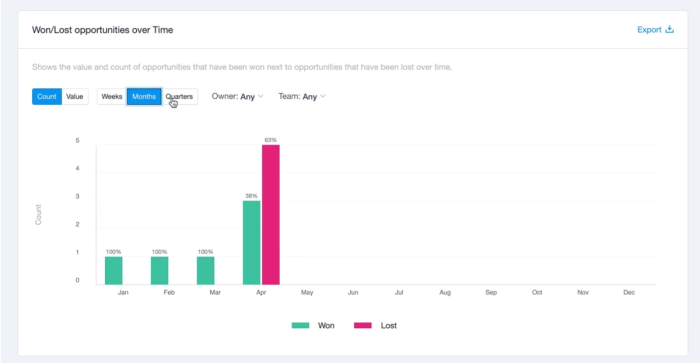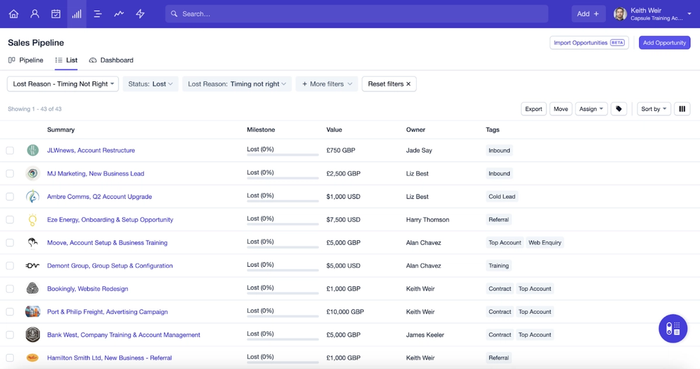We live in the age of Big Data, where businesses have access to more customer information than ever before. However, many organizations struggle to move beyond basic demographic data, or they’re can’t extract meaningful information.
This lack of insight often leads to missed opportunities and inefficient marketing activities. Without a deep understanding of customer behavior and preferences, businesses risk wasting valuable resources on campaigns that fail to resonate with their audience. Even worse, they may lose customers to competitors who are better equipped to deliver personalized experiences and anticipate customer needs.
CRM analytics help by turning your raw customer data into actionable insights. You can get a 360-degree view of your customers, uncover hidden patterns, and predict future trends.
In this article, you’ll learn exactly what CRM analytics is, its key benefits, and the tools you need to maximize its potential. By the end, you’ll understand how CRM analytics can help your business transform customer data into a valuable asset.
What is CRM analytics?
CRM analytics refers to gathering, analyzing, and interpreting lots of customer data from your customer relationship management (CRM) systems.
CRM analytics goes beyond simply storing customer information – it transforms this data into meaningful insights. You can then use these observations to optimize customer experiences, improve customer satisfaction, and increase overall business efficiency.
To fully grasp the potential of CRM analytics, you need to understand the four different types of analytics:
- Descriptive analytics: provide a clear picture of what has happened in the past by analyzing historical data to identify trends, patterns, and customer segments. For example, businesses can use descriptive analytics to understand which products were the best-sellers last quarter or which marketing campaigns generated the most leads.
- Predictive analytics: involves forecasting future customer behaviors and trends based on historical data. By applying statistical models and machine learning algorithms, businesses can predict customer actions such as the likelihood of a purchase or churning.
- Prescriptive analytics takes your predictive insights further by recommending specific actions to optimize your results. For example, if there’s a high likelihood of customer churn, prescriptive analytics might suggest targeted retention strategies such as personalized offers or a targeted email marketing campaign.
- Diagnostic analytics focuses on understanding the reasons behind certain customer behaviors or actions. For instance, if you notice a sudden drop in sales, diagnostic analytics can help identify the contributing factors, such as a recent change in pricing or a competitor’s new launch.
By integrating these different types of analytics, businesses can gain a comprehensive understanding of their customers, from what has happened previously to what might happen in the future and how to respond effectively.
As we’ll go on to see, tools like Capsule enhance your CRM analytics by offering useful features that allow users to drill down into specific data points and uncover detailed insights.

What are the benefits of CRM analytics?
Knowledge is power, and using CRM analytics offers a multitude of benefits that can significantly impact your business’s bottom line. You can use what you’ve learned to optimize strategies across various teams, from marketing to sales to customer service. Here are some of the key benefits:
Enhanced customer segmentation
As you get to know your customers better, it becomes easier to segment them in meaningful ways. CRM analytics allows you to segment customers more effectively by analyzing behavioral data, purchase history, and other interactions.
With better segmentation, you can create highly targeted marketing campaigns tailored to specific customer groups, increasing the likelihood they’ll engage and convert. For example, by identifying high-value customers who frequently make large purchases, you can offer personalized exclusive offers or loyalty programs to retain these valuable customers and encourage repeat business.
Increased sales and revenue
Analyzing customer data lets you uncover cross-sell and upsell opportunities that drive additional revenue. CRM analytics helps your sales teams identify patterns and behaviors that indicate a customer’s readiness to purchase or upgrade to a higher-tier product.
For example, if your data shows a customer frequently purchases a particular product, your sales team can recommend complementary products or services that match the customer’s interests. This targeted approach not only increases sales but, when done correctly, also enhances the overall customer experience with relevant recommendations.
Better marketing ROI
CRM analytics provides valuable insights into the effectiveness of your marketing campaigns, meaning you can measure your return on investment (ROI) more accurately. By tracking metrics such as click-through rates, conversion rates, and customer acquisition costs (CAC), you can see which campaigns are performing well and which need refining.
You can allocate your budget based on solid data, focusing on high-performing strategies that deliver the best results. Additionally, by continuously analyzing campaign performance, you can quickly pivot and optimize your efforts, leading to improved marketing outcomes and higher ROI.
Streamlined customer support
CRM analytics also help with post-sale to improve customer service teams. Support teams can identify common customer issues and trends, enabling them to address problems more quickly and effectively. By analyzing your customer interactions, support teams can also develop relevant knowledge bases, FAQs, and self-service options that reduce the volume of support requests and speed up resolutions.
Data-driven decision making
One of the biggest advantages of CRM analytics is its ability to improve your decision-making. By getting a clear picture of customer behaviors, preferences, and trends, you can make informed decisions that align with your strategic goals.
Whether it’s launching a new product, entering a new market, or adjusting pricing strategies, you can rely on data insights to guide your actions, reducing the risk of costly mistakes and improving overall business results.
Key insights from CRM analytics
CRM analytics provides businesses with powerful insights that go beyond traditional metrics, allowing them to uncover deeper trends and patterns that directly impact sales and customer relationships. Here are five critical insights that businesses can derive from CRM analytics:
Won/Lost Opportunities
CRM analytics helps you review your sales efforts – specifically, which deals were successfully closed (won) and which were not (lost). By examining the characteristics of won and lost opportunities (such as deal size, industry, sales cycle length, and the tactics used), you’ll soon identify commonalities; patterns and factors that contribute to successful outcomes.
This analysis allows your sales teams to refine their approach, focusing on strategies and customer segments with higher success rates while addressing the common pitfalls that lead to lost deals.

Leaking Pipeline
Where are potential deals dropping off or stalling in your sales pipeline? CRM analytics can help businesses identify these leaks by tracking the opportunities as they progress through the pipeline and pinpointing where prospects are most likely to be lost.
By understanding where leaks occur – whether at the initial contact stage, during negotiations, or just before closing – you can then take action to address these issues. For example, if a significant number of deals are lost during the negotiation phase, your sales team might need additional training in negotiation techniques or improved sales collateral to deal with customer objections better.
Average Time to Won
How long does it take for an opportunity to move from initial contact to a successful close? This insight is critical for understanding the efficiency of your sales process and identifying any delays or bottlenecks in the sales cycle.
A longer-than-expected Average Time to Won may indicate issues such as ineffective follow-ups, lengthy negotiation processes, or a lack of urgency among the sales team. By analyzing this data, you can implement strategies to shorten the sales cycle, ultimately improving sales velocity and boosting revenue.
Average Sales Value
How much revenue are you generating from each closed deal? Understanding Average Sales Value helps you set realistic revenue targets and identify customer spending behavior. If the Average Sales Value is decreasing, it may signal a shift in customer preferences or a need to adjust pricing strategies.
On the other hand, an increasing Average Sales Value might indicate a successful upselling and cross-selling program or a good mix of complementary products. By closely monitoring this insight, you can optimize their pricing strategies and sales efforts to maximize revenue.
Lost Reasons
Understanding exactly why a deal fails to close gives you a golden opportunity to refine your sales strategies and improve win rates.
For example, if a significant number of deals are lost due to pricing concerns, you might consider adjusting your pricing strategy or offering flexible payment terms. Alternatively, if deals are lost to competitors, the sales team may need better competitive intelligence and stronger sales pitches.
The best tools and platforms for CRM analytics
To fully harness the power of CRM analytics, businesses need the right tools and platforms. Capsule provides a user-friendly interface and robust analytics features that let you drill deep into your CRM data, uncover valuable insights, and make smarter decisions.
For example, Capsule’s reporting feature enables businesses to analyze their CRM data in greater detail. With saved lists, users can create customized views of their data, filter by specific criteria (such as deal stage, value, or custom tags and fields), and generate reports that provide deeper insights into their sales and customer relationship processes.
For example, businesses can use saved lists to see a list of all lost opportunities along with the reason for the loss. By extracting these insights directly from the CRM, you can reach out to potential customers where the timing wasn’t quite right before to see if things have changed.

Saved lists are highly customizable, allowing you to create specific queries that match your unique business needs. This flexibility means you can focus on the data points that matter most to you, whether that’s tracking customer interactions, monitoring sales performance, or understanding customer preferences. Plus, saved lists are dynamic and updated in real-time as you get new data, so you’ll always be working with the latest information.
While Capsule’s reports and lists provide valuable insights directly from the CRM, you can further enhance its analytics capabilities by exporting this data to advanced business intelligence (BI) tools like Power BI or Looker Studio. These BI tools offer sophisticated data visualization and reporting capabilities for unparalleled insights. By integrating Capsule with your favorite BI tools, you can create more advanced, visual reports that provide a comprehensive view of your sales and customer data.
See your customer data in a whole new light
For most modern businesses, there’s no shortage of data. The real challenge is knowing how to decipher that data in a way that benefits the business. CRM analytics help you harness the full potential of your customer data. By delving deep into your CRM insights, you can better understand customer behaviors, optimize your sales processes, and make data-driven decisions that drive growth and profitability.
Capsule CRM, with its robust reporting features and saved lists, offers a powerful platform for extracting these insights directly from your CRM data. By using Capsule’s capabilities alongside other advanced business intelligence tools, you can take your analytics to the next level.
By investing in the right tools and adopting a data-driven approach, businesses can not only stay ahead of the competition but also build stronger, more profitable relationships with their customers.




